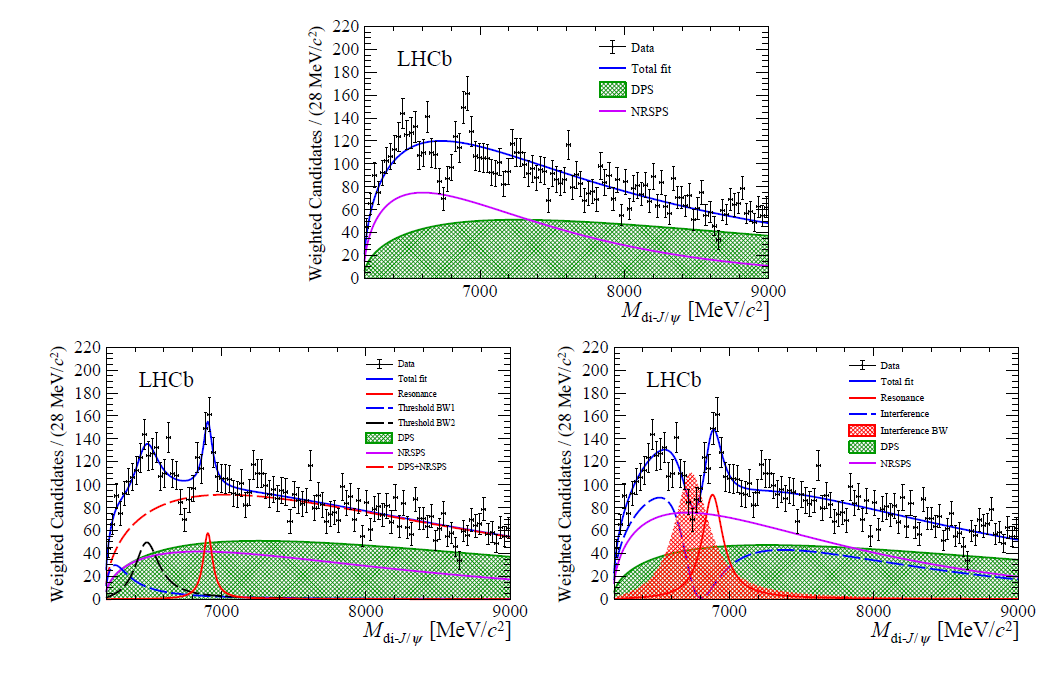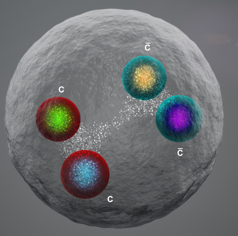A “smoking gun” for tightly bound tetraquarks?
Today, the LHCb collaboration submitted a paper reporting the discovery of a possible tetraquark candidate, Tcccc, composed of two charm quarks and two charm antiquarks, referred to as the X(6900) in the paper. These results have been already presented at a CERN seminar on June 16th. The full Run 1 and Run 2 data sets are used in this analysis. The invariant-mass spectrum of prompt-J/ψ pairs is investigated, where the J/ψ mesons are reconstructed through the decay J/ψ→μ+μ–. The three images below show the data (black points with error bars) analysed under different assumptions as explained in the seminar and paper. A narrow peaking structure at 6900 MeV/c2, matching the expected signature of the production of a new particle, and a broader structure around 6400-6600 MeV/c2, close to the threshold, are observed. The top plot shows the null hypothesis of only continuum J/ψ pair production, which is found to be inconsistent with the data by more than 5σ in the mass range 6200-7400 MeV/c2 in which particles composed of four charm quarks have been predicted. The decay of the new particle into the J/ψ pair suggests a minimum quark content of cccc, consistent with a Tcccc tetraquark interpretation.

This is the first observation of this unusual combination of heavy quarks. Indeed all the exotic hadrons observed so far have at most two heavy quarks and none of them is made of more than two quarks of the same type.
The peak at around 6900 MeV/c2 closely resembles what would be expected for a Tcccc tetraquark particle, while the threshold bump could be due to another Tcccc tetraquark, a combination of several overlapping tetraquark peaks, or a more complicated decay of a Tcccc in which additional final-state particles were created beyond the two J/ψ that were reconstructed.
A special effort was made to enhance the contribution, in the J/ψ-pair invariant-mass spectrum, of events that could potentially contain tetraquarks with respect to those that could not. Prompt J/ψ pairs can be produced both through double-parton (quark or gluon) scatterings (DPS), where the two J/ψ mesons are produced independently in separate partonic interactions, and single parton scattering (SPS), which includes non-resonant and Tcccc production. Specific criteria, explained in the paper, were applied in the analysis in order to enhance the selection of SPS over the DPS events in the final sample.
In the conventional quark model, strongly interacting particles, known as hadrons, are formed either from quark-antiquark pairs (mesons) or three quarks (baryons). Particles which cannot be classified within this scheme are referred to as exotic hadrons. In their fundamental 1964 papers [1] and [2], in which they proposed the quark model, Murray Gell-Mann and George Zweig mentioned the possibility of adding a quark-antiquark pair to a minimal meson or baryon quark configuration to form hadrons with four (tetraquark) or five (pentaquark) quark constituents. It took 50 years, however, for physicists to obtain unambiguous experimental evidence of the existence of these exotic hadrons. In April 2014 the LHCb collaboration published measurements that demonstrated that the Z(4430)+ particle, first observed by the Belle collaboration, is composed of four quarks (ccdu). Then, a major turning point in exotic baryon spectroscopy was achieved at the Large Hadron Collider in July 2015 when, from an analysis of Run 1 data, the LHCb collaboration reported significant pentaquark structures in the J/ψp mass distribution in Λb0→ J/ψpK– decays.
Various interpretations of these multi-quark structures have been proposed, including tightly bound four- or five-quark states and loosely bound molecular meson-meson or baryon-meson states. Which possibility is realized in nature? Well, perhaps both. The LHCb results presented two weeks ago are a clear example of this puzzle, as the χc1(3872) particle could be interpreted as a quasi-bound D0D*0 molecule, being a tightly bound four-quark state also a possible explanation of its nature. The newly observed Tcccc tetraquark represents the first observation of a highly unusual combination of four charm quarks. Unraveling the mystery of the nature of this new particle will provide an exceptional laboratory to test and constrain many theoretical models. On the one hand, the observed mass peak could represent a “smoking gun” proof for the existence of tightly bound four-quark systems possibly composed of a diquark and an anti-diquark mediated by a short-range qluon exchange, as shown in the image. This interpretation may be hinted by the fact that the mass of the particle seen is located above the masses of known charmonium cc and exotic X, Y and Z particles, as well as below the bottomonium bb system. But, on the other hand, interpretation as a di-meson molecular state, or the possibility that the observed peak hides a more complex underlying structure are also well plausible.
Today’s discovery will trigger additional intensive activity among theoretical physicists. The LHCb collaboration continues the search for new, not yet discovered, exotic particles and the study of their properties.
Read more in the LHCb CERN seminar presentation and paper, in the CERN update in English and French and also in the CERN Courier article.

